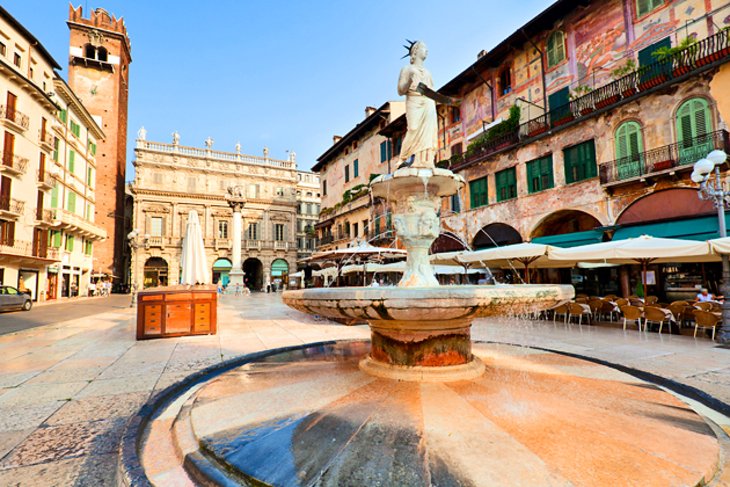 Do House of Juliet i San Fermo
Do House of Juliet i San Fermo
Via Mazzini is narrow, a pedestrian street north of the Arena, with mainly expensive clothing stores, shoes and jewelry. Turning left at the end of the street, you come to Piazza delle Erbe (look down), and to the right to via Cappello, a street named after the family, which Shakespeare immortalized as Capulets; on the left side, at number 23, is located Casa di Giulietta (Juliet's House). Although the Capulet and Montek families really existed, Romeo and Juliet are completely made up characters. The house itself, erected at the beginning of the 14th century. and perfectly preserved, is open to the public (wt.-nd. 8.00-18.45; 3000 L).
Via Cappello prowadzi do via Leone, where is the roman gate, Lion Gate, and a fragment of an unearthed Roman street three meters underground. At the end of via Leone, on the other side, the brick Basilica di San Fermo rises, whose incoherent interior reveals, that they are actually two churches joined. The flood forced the Benedictines to erect the second building on top of the first, established in the 8th century. In the upper church, gothic, there are no great works of art, but he has a certain grace; in the lower church, Romanesque, which is entered to the left of the choir, there is an impressive low ceiling. Sometimes exhibitions are held here.
Piazza delle Erbe i Piazza dei Signori
From the beginning, Piazza delle Erbe was an important Roman crossroads and the forum, and remains the heart of the city to this day. As the name suggests, at the local market mainly vegetables were traded; today the assortment includes clothes, souvenirs, antiques and snacks. The most striking of the diverse buildings around the square are the Domus Mercatorium (on the left, viewed from via Cappello), originated in 1301 r. as a warehouse and merchant's exchange, The 14th-century Torre del Gardello and, to the right of her, Mazzanti House, whose 16th-century wall paintings are best viewed after dark, in the spotlight.
Lords Square, which is next to it, was formerly the main city square in Verona. Most of the right side is occupied by the Palazzo del Capitano, separated from the Palazzo del Comune by a section of an excavated Roman street. Upon entering the square, it becomes in front of the medieval Palazzo degli Scaligeri, the family residence; in the neighborhood there is a memento of more democratic times, XV-wieczna Loggia of the Council, former council hall and an excellent example of early renaissance architecture in Verona. Among the many figures of outstanding figures placed on the roof is the most eminent Polish poet in Verona, Catullus. There is a great view of the city from the 12th-century Torre de Lamberti, on the right after entering the square (wt.-nd. 8.00-18.45; 2500 L elevator, 1500 L on foot).
Scaliger tombs
Passing under the arch connecting the Palazzo degli Scaligeri with the Palazzo del Capitano you will come across the small Romanesque Church of Santa Maria Antica, facing the Arche Scaligeri, one of the most sophisticated tombs in Italy. Above the side entrance to the church is the equestrian statue of Cangrande I ("Big Dog", d. 1329), smiling at the top of the tomb roof; the statue is a copy, and the original can be seen in Castelvecchio (look down). The vaulted tombs of the rest of the clan are surrounded by a wrought-iron palisade, decorated with a ladder motif, which is the emblem of the Scaliger family - the family name was della Scala, and "scala" means ladder. (You can enter the fenced area Tue-Sun. 9.00-12.00 i 14.30-18.00). Mastiff I ("Mastiff"), founder of the dynasty, he is buried in a simple grave against the church wall, Mastino II to the left of the entrance, opposite the most decorated tomb, belonging to Cansignorio („Pies-senior”; d. 1375).
Sant’Anastasia i Duomo
Passing Arche Scaligeri and turning left onto Via San Pietro, it comes to Sant'Anastasia, the largest church in Verona. Started in 1290, and completed in 1481 r. the building is mainly gothic, with some romanesque shades. From the outside, the fourteenth-century door carvings attract the most attention, depicting scenes from the New Testament; the most interesting monument in the interior (in the sacristy) there is a fresco by Pisanella Saint George and the Princess, painting with delicate colors, in which this usually fighting saint plays the role of a dandy.
The red and white striped Verona Duomo is located just behind a bend in the river, behind the Romanesque Ponte Pietra. The one consecrated in 1187 r. the church is romanesque in the lower parts, and upwards gradually becomes gothic; two porches from the 12th century. - in the south, Jonah's story with the whale is visible, and in the west images of Roland and Oliver, two paladins of Charlemagne. Inside, each chapel and columns have a fascinating architectural detail, especially beautiful is the Cappella Mazzanti (last on the right). In the first chapel on the left, the Assumption of Titian occupies an architectural frame, made by Sansovin, which also designed the choir.